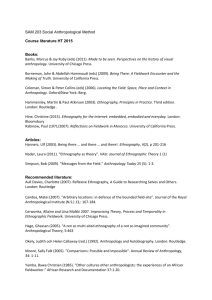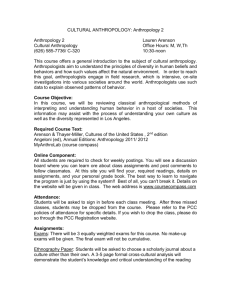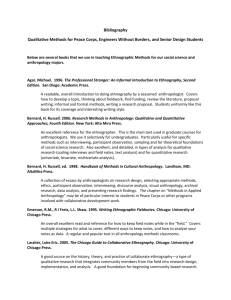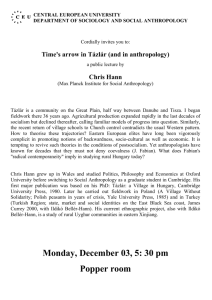Anthropology 1 - Laramie County School District #01
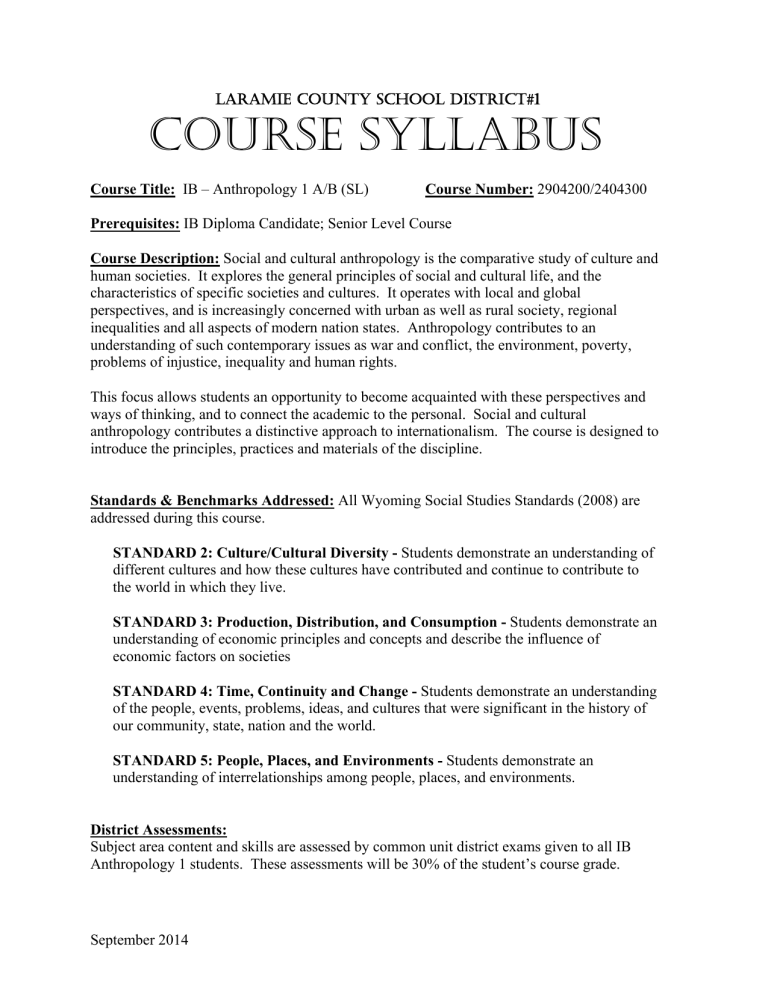
LARAMIE COUNTY SCHOOL DISTRICT#1
COURSE SYLLABUS
Course Title: IB – Anthropology 1 A/B (SL) Course Number: 2904200/2404300
Prerequisites: IB Diploma Candidate; Senior Level Course
Course Description: Social and cultural anthropology is the comparative study of culture and human societies. It explores the general principles of social and cultural life, and the characteristics of specific societies and cultures. It operates with local and global perspectives, and is increasingly concerned with urban as well as rural society, regional inequalities and all aspects of modern nation states. Anthropology contributes to an understanding of such contemporary issues as war and conflict, the environment, poverty, problems of injustice, inequality and human rights.
This focus allows students an opportunity to become acquainted with these perspectives and ways of thinking, and to connect the academic to the personal. Social and cultural anthropology contributes a distinctive approach to internationalism. The course is designed to introduce the principles, practices and materials of the discipline.
Standards & Benchmarks Addressed: All Wyoming Social Studies Standards (2008) are addressed during this course.
STANDARD 2: Culture/Cultural Diversity - Students demonstrate an understanding of different cultures and how these cultures have contributed and continue to contribute to the world in which they live.
STANDARD 3: Production, Distribution, and Consumption - Students demonstrate an understanding of economic principles and concepts and describe the influence of economic factors on societies
STANDARD 4: Time, Continuity and Change - Students demonstrate an understanding of the people, events, problems, ideas, and cultures that were significant in the history of our community, state, nation and the world.
STANDARD 5: People, Places, and Environments - Students demonstrate an understanding of interrelationships among people, places, and environments.
District Assessments:
Subject area content and skills are assessed by common unit district exams given to all IB
Anthropology 1 students. These assessments will be 30% of the student’s course grade.
September 2014
Standards Proficiency:
Students must be proficient in at least 5 content areas to graduate from high school in LCSD, one of which could be social studies. Proficiency on standards aligned to a course will be earned if a student earns a combined average of 70% for the two semesters of the course and passes both semesters.
Course Organization:
For this course there are three compulsory parts:
I.
Underlying Principles a.
Approaches to the analysis of society and culture b.
Key concepts c.
Methods d.
Construction of ethnographic accounts e.
Relevance of social and cultural anthropology
II.
Themes a.
Social organization b.
Systems of belief and knowledge c.
Processes of change and transformation
III.
Ethnographic Materials a.
Ethnographies b.
Cultural materials c.
Student’s own social and cultural knowledge
Instructional Materials:
Invitation to Anthropology , 3 rd edition, by Luke Eric Lassiter, 2009.
Anthropology Unbound by E. Paul Durrenberger and Suzan Erem, 2010.
The Dobe Ju’hoansi , the third edition published in 2002, a classic ethnography of a hunter/gatherer group in the Kalahari Desert in Southern Africa, written by Richard Lee.
Study began in 1953, first published in 1983. The work continues today.
Sleeping Rough in Port-au-Prince : An Ethnography of Street Children and Violence in
Haiti by J. Christopher Kovats-Bernat, 2006, based on fieldwork conducted from 1994 to
2004, the decade of Haiti’s transition from a dictatorship to a democracy. The author lived on the streets with many children and looked to advance the study of children in anthropology as important informants and agents of cultural change.
Supplemental Materials:
With No Direction Home by Marni Finkelstein, published in 2005, using data collected from 50 homeless kids in the East Village of NY City over two consecutive summers. Finkelstein wished to investigate the kids’ actual experience on the streets, their own explanations for being there, what it takes to be on the streets, as well as background factors involved in getting them to the streets.
A Tribe Apart by Patricia Hersch, published in 1999, six-years of ethnographic work with eight Reston, Virginia, students.
September 2014
Colin Turnbull’s The Mbuti Pygmies: Change and Adaptation , a more classic ethnography first published in 1983 and based on work done with the Mbuti of the
Ituri Rain Forest in the geographical center of Africa in what was known at the time of the fieldwork as the Belgian Congo, and now known as Zaire. We learn about how the Mbuti organize themselves around the centrality of the forest, which is, to them, sacred.
Across the Wire: Life and Hard Times on the Mexican Border by Luis Alberto
Urrea, published in 1993. A contemporary ethnography about refugees living on the
Mexican side of the border, only twenty-some miles from San Diego and yet a world apart. Urrea, who now lives in Boulder, Colorado, writes about his work as a translator working with a crew of relief workers. He pulls no punches in his writing and declares himself to be openly and rightfully subjective.
Selections from:
Anthropology: A Student’s Guide to Theory and Method by Stanley R.
Barrett, published in 2002, chapter one, “Unleashing the Anthropologist: A
Historical Overview”, pages 47-68; chapter introductions, key theories and concepts, and chapter evaluations.
Visions of Culture by Jerry D. Moore, presenting particular theorists and theories, 2004
Core Concepts in Cultural Anthropology by Robert H. Lavenda and Emily
A. Schultz, 2003
Distant Mirrors: America as a Foreign Culture , editors Philip R. DeVits and James D. Armstrong
September 2014




